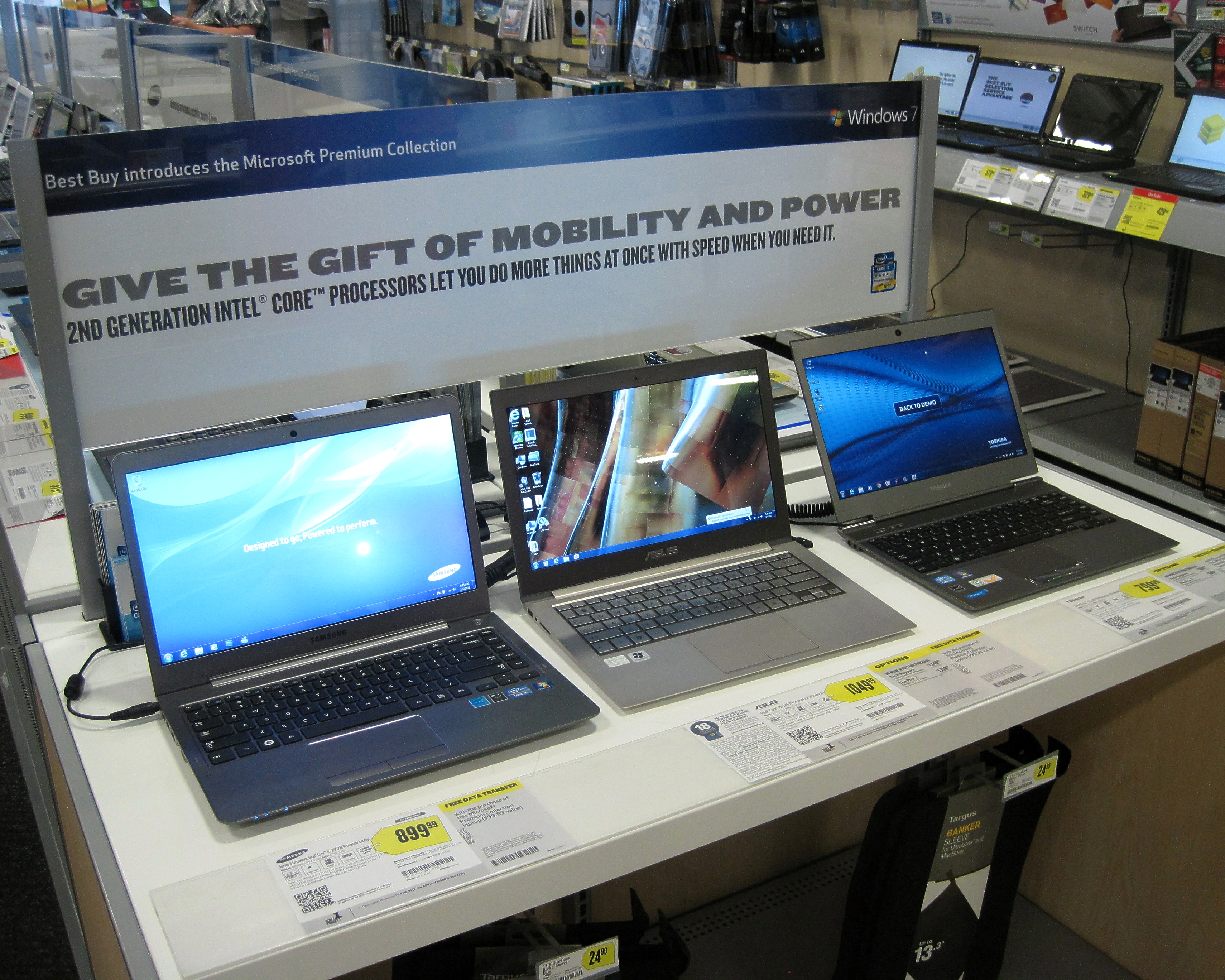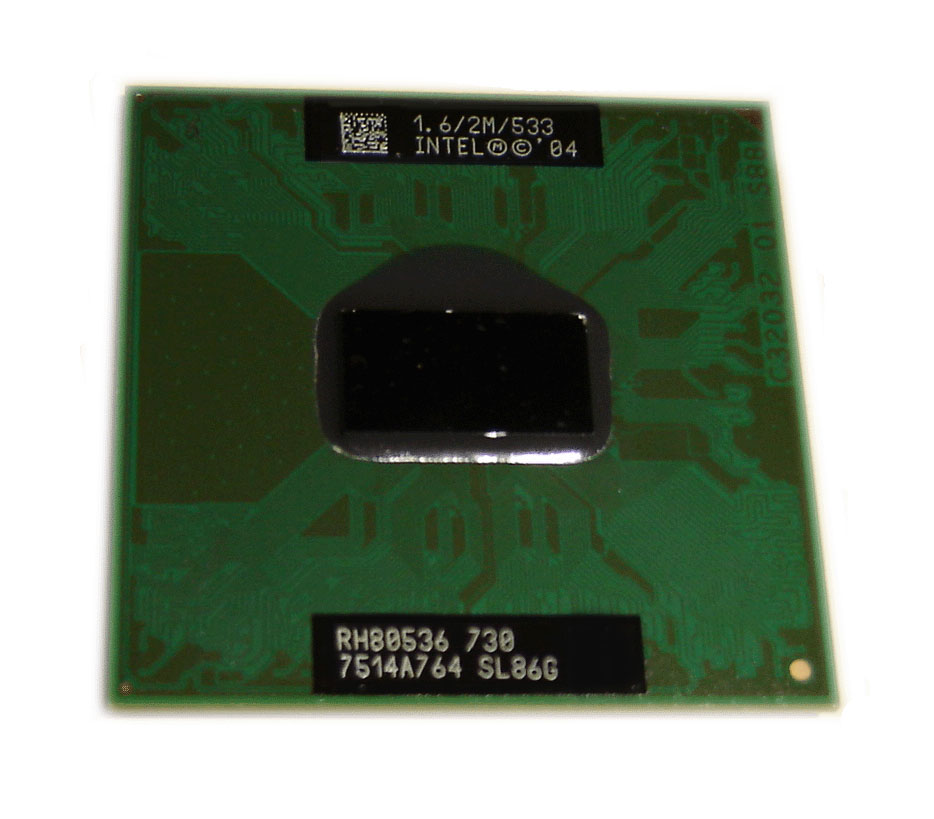|
Centrino
Centrino was a brand name of Intel Corporation which represented its Wi-Fi and WiMAX wireless computer networking adapters. The brand name was first used by the company as a platform-marketing initiative. The change of the meaning of the brand name occurred on January 7, 2010. The Centrino name for laptops was replaced by the Ultrabook. The old platform-marketing brand name covered a particular combination of mainboard chipset, mobile CPU and wireless network interface in the design of a laptop. Intel claimed that systems equipped with these technologies delivered better performance, longer battery life and broader wireless network interoperability than non-Centrino systems. The product line name for Intel wireless products became Intel Centrino Wireless in 2010. The Centrino brand was ultimately discontinued in 2013. Intel Centrino Notebook implementations Carmel platform (2003) Intel used " Carmel" as the codename for the first-generation Centrino platform, introduced ... [...More Info...] [...Related Items...] OR: [Wikipedia] [Google] [Baidu] [Amazon] |
Ultrabook
Ultrabook is a class of premium consumer-grade notebook computers. The term was originated by and is trademarked by Intel, replacing the earlier Centrino mobile platform. Introduced in 2011, they were originally marketed as featuring ultra thin form factor and light weight design without compromising battery life or performance, running on Intel Core processors. When newly introduced, Ultrabooks were generally small enough compared to average laptop models to qualify as subnotebooks. As ultrabook features became more mainstream in the mid-late 2010s, explicitly branding laptop models as "ultrabooks" became much less frequent. As of 2021, while Intel maintains the Ultrabook trademark, it is rarely used for new models and has been superseded in Intel's own marketing by the Intel Evo branding. History In 2011, Intel Capital press officer Jordan Balk Schaer announced a new fund to support startups working on technologies in line with the company's concept for next generation ... [...More Info...] [...Related Items...] OR: [Wikipedia] [Google] [Baidu] [Amazon] |
Pentium M
The Pentium M is a family of mobile 32-bit single-core x86 microprocessors (with the modified Intel P6 (microarchitecture), P6 microarchitecture) introduced in March 2003 and forming a part of the Intel Centrino#Carmel platform (2003), Carmel notebook platform under the then new Centrino brand. The ''Pentium M'' processors had a maximum thermal design power (TDP) of 5–27 W depending on the model, and were intended for use in laptops (thus the "M" suffix standing for ''mobile''). They evolved from the core of the last Pentium III–branded CPU by adding the front-side bus (FSB) interface of Pentium 4, an improved instruction decoding and issuing front end, improved branch predictor, branch prediction, SSE2 support, and a much larger cache. The Pentium M replaced the laptop version of the Pentium 4 (the ''Pentium 4-Mobile'', or ''P4-M''), which suffered from power consumption and heat problems. The first Pentium M–branded CPU, code-named Banias, was followed by Dothan. The Pent ... [...More Info...] [...Related Items...] OR: [Wikipedia] [Google] [Baidu] [Amazon] |
Dothan (microprocessor)
The Pentium M is a family of mobile 32-bit single-core x86 microprocessors (with the modified Intel P6 microarchitecture) introduced in March 2003 and forming a part of the Intel Carmel notebook platform under the then new Centrino brand. The ''Pentium M'' processors had a maximum thermal design power (TDP) of 5–27 W depending on the model, and were intended for use in laptops (thus the "M" suffix standing for ''mobile''). They evolved from the core of the last Pentium III–branded CPU by adding the front-side bus (FSB) interface of Pentium 4, an improved instruction decoding and issuing front end, improved branch prediction, SSE2 support, and a much larger cache. The Pentium M replaced the laptop version of the Pentium 4 (the ''Pentium 4-Mobile'', or ''P4-M''), which suffered from power consumption and heat problems. The first Pentium M–branded CPU, code-named Banias, was followed by Dothan. The Pentium M line was removed from the official price lists in July 2009, whe ... [...More Info...] [...Related Items...] OR: [Wikipedia] [Google] [Baidu] [Amazon] |
Intel Corporation
Intel Corporation is an American multinational corporation and technology company headquartered in Santa Clara, California, and incorporated in Delaware. Intel designs, manufactures, and sells computer components such as central processing units (CPUs) and related products for business and consumer markets. It is one of the world's largest semiconductor chip manufacturers by revenue, and ranked in the ''Fortune'' 500 list of the largest United States corporations by revenue for nearly a decade, from 2007 to 2016 fiscal years, until it was removed from the ranking in 2018. In 2020, it was reinstated and ranked 45th, being the 7th-largest technology company in the ranking. It was one of the first companies listed on Nasdaq. Intel supplies microprocessors for most manufacturers of computer systems, and is one of the developers of the x86 series of instruction sets found in most personal computers (PCs). It also manufactures chipsets, network interface controllers, fl ... [...More Info...] [...Related Items...] OR: [Wikipedia] [Google] [Baidu] [Amazon] |
GMA 900
The Intel Graphics Media Accelerator (GMA) is a series of integrated graphics processors introduced in 2004 by Intel, replacing the earlier Intel Extreme Graphics series and being succeeded by the Intel HD and Iris Graphics series. This series targets the market of low-cost graphics solutions. The products in this series are integrated onto the motherboard, have limited graphics processing power, and use the computer's main memory for storage instead of a dedicated video memory. They were commonly found on netbooks, low-priced laptops and desktop computers, as well as business computers which do not need high levels of graphics capability. In early 2007, about 90% of all PC motherboards sold had an integrated GPU. History The GMA line of GPUs replaces the earlier Intel Extreme Graphics, and the Intel740 line, the latter of which was a discrete unit in the form of AGP and PCI cards with technology that evolved from companies Real3D and Lockheed Martin. Later, Intel integrat ... [...More Info...] [...Related Items...] OR: [Wikipedia] [Google] [Baidu] [Amazon] |
Intel PRO/Wireless
Intel PRO/Wireless is a series of wireless products developed by Intel. These products include wireless network adapters, access points, and routers that are designed to provide high-speed wireless connectivity for computers, laptops, and other devices. Intel PRO/Wireless products use various wireless technologies, including Wi-Fi (IEEE 802.11) and Bluetooth, to provide wireless connectivity. Intel PRO/Wireless network adapters allow devices to connect to wireless networks, while access points and routers create wireless networks that devices can connect to. Intel PRO/Wireless products are commonly used in homes, offices, and other settings where wireless connectivity is desired. They are known for their high performance and reliability, and are often used in business environments where a reliable wireless connection is critical. Intel PRO/Wireless products are also used in some public places, such as airports, hotels, and coffee shops, where they can be used to provide wireless acc ... [...More Info...] [...Related Items...] OR: [Wikipedia] [Google] [Baidu] [Amazon] |
IEEE 802
IEEE 802 is a family of Institute of Electrical and Electronics Engineers (IEEE) standards for local area networks (LANs), personal area networks (PANs), and metropolitan area networks (MANs). The IEEE 802 LAN/MAN Standards Committee (LMSC) maintains these standards. The IEEE 802 family of standards has had twenty-four members, numbered 802.1 through 802.24, with a working group of the LMSC devoted to each. However, not all of these working groups are currently active. The IEEE 802 standards are restricted to computer networks carrying variable-size packets, unlike cell relay networks, for example, in which data is transmitted in short, uniformly sized units called cells. Isochronous signal networks, in which data is transmitted as a steady stream of octet (computing), octets, or groups of octets, at regular time intervals, are also outside the scope of the IEEE 802 standards. The number 802 has no significance: it was simply the next number in the sequence that the IEEE used fo ... [...More Info...] [...Related Items...] OR: [Wikipedia] [Google] [Baidu] [Amazon] |
Front-side Bus
The front-side bus (FSB) is a computer communication interface ( bus) that was often used in Intel-chip-based computers during the 1990s and 2000s. The EV6 bus served the same function for competing AMD CPUs. Both typically carry data between the central processing unit (CPU) and a memory controller hub, known as the northbridge. Depending on the implementation, some computers may also have a back-side bus that connects the CPU to the cache. This bus and the cache connected to it are faster than accessing the system memory (or RAM) via the front-side bus. The speed of the front side bus is often used as an important measure of the performance of a computer. The original front-side bus architecture was replaced by HyperTransport, Intel QuickPath Interconnect, and Direct Media Interface, followed by Intel Ultra Path Interconnect and AMD's Infinity Fabric. History The term came into use by Intel Corporation about the time the Pentium Pro and Pentium II products were announ ... [...More Info...] [...Related Items...] OR: [Wikipedia] [Google] [Baidu] [Amazon] |
Wireless Network
A wireless network is a computer network that uses wireless data connections between network nodes. Wireless networking allows homes, telecommunications networks, and business installations to avoid the costly process of introducing cables into a building, or as a connection between various equipment locations. Admin telecommunications networks are generally implemented and administered using radio communication. This implementation takes place at the physical level (layer) of the OSI model network structure. Examples of wireless networks include cell phone networks, WLAN, wireless local area networks (WLANs), wireless sensor networks, satellite communication networks, and terrestrial microwave networks. History Wireless networks The first professional wireless network was developed under the brand ALOHAnet in 1969 at the University of Hawaii and became operational in June 1971. The first commercial wireless network was the WaveLAN product family, developed by NCR Corpor ... [...More Info...] [...Related Items...] OR: [Wikipedia] [Google] [Baidu] [Amazon] |
Atheros
Atheros Communications, Inc., was an American computer networking company independently active from 1998 to 2011. It produced semiconductor chips for network communications, particularly wireless chipsets. The company was founded under the name T-Span Systems in 1998 by experts in signal processing and VLSI design from Stanford University, the University of California, Berkeley, and private industry. The company was renamed Atheros Communications in 2000 and it completed an initial public offering in February 2004, trading on the NASDAQ under the symbol ATHR. On January 5, 2011, it was announced that Qualcomm had agreed to a takeover of the company for a valuation of US$3.7 billion. When the acquisition was completed on May 24, 2011, Atheros became a subsidiary of Qualcomm operating under the name Qualcomm Atheros. Qualcomm Atheros chipsets for the IEEE 802.11 standard of wireless networking are used by over 30 different wireless device manufacturers. History T-Span Systems ... [...More Info...] [...Related Items...] OR: [Wikipedia] [Google] [Baidu] [Amazon] |
Mini PCI
Peripheral Component Interconnect (PCI) is a local computer bus for attaching hardware devices in a computer and is part of the PCI Local Bus standard. The PCI bus supports the functions found on a processor bus but in a standardized format that is independent of any given processor's native bus. Devices connected to the PCI bus appear to a bus master to be connected directly to its own bus and are assigned addresses in the processor's address space. It is a parallel bus, synchronous to a single bus clock. Attached devices can take either the form of an integrated circuit fitted onto the motherboard (called a ''planar device'' in the PCI specification) or an expansion card that fits into a slot. The PCI Local Bus was first implemented in IBM PC compatibles, where it displaced the combination of several slow Industry Standard Architecture (ISA) slots and one fast VESA Local Bus (VLB) slot as the bus configuration. It has subsequently been adopted for other computer types. Ty ... [...More Info...] [...Related Items...] OR: [Wikipedia] [Google] [Baidu] [Amazon] |





